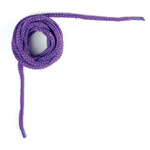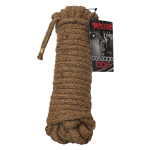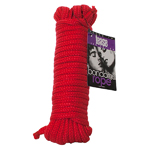Beginner's Guide To Rope Bondage Tying

So, you’ve decided to tie the knot? Well, bondage rope tying is one experience that guarantees to bind you for life. Rope work is staple play for many BDSM enthusiasts. Not only does it keep your sub firmly in their place, it sets a superb scene, and looks incredible. So if you revel in restraint, are curious about kinbaku, or simply think you’re about ready to be tied down, you’ve come to the right place. As always, UberKinky is here to show you the ropes.
Using bondage rope during sex - or even if there’s no actual sex involved - plays a HUGE part in the D of BDSM. That’s dominance, in case you’re uninitiated. Also, the B for bondage, of course. For Doms in the relationship - those who like to be in charge - you will love tying up your partner and having your wicked way with them. If you’re at the other end of the spectrum, subs will enjoy the complete loss of control - not to mention the enhanced pleasure that comes with.
If you thought all you needed was a willing partner, some ropes, and the ability to tie a knot, don’t be surprised if what you actually end up with is an disgruntled bottom telling you to “get knotted”! There are many different ways people choose to engage in rope bondage, but here are the UberKinky tried and tested methods;
Symmetrical
For all of you neat freaks out there. Symmetrical rope bondage is a comfortable choice, making it ideal for beginners. It promotes a calming environment and delivers mirrored perfection. One example of symmetrical rope bondage is tying both hands together.
Asymmetrical
Want to mix things up? Asymmetrical rope bondage is a good choice for punishment as it can be uncomfortable and is harder to adapt to than symmetrical. For that reason, we wouldn’t recommend it to beginners. One example of asymmetrical rope bondage is tying the right wrist to the left ankle.
Suspension Bondage
For keeping the bottom in suspense. We cannot stress this enough; do not try suspension bondage unless you have undergone some serious training beforehand. Even then it is essential to have an expert present the first few times you try; and whatever you do, don’t leave them hanging unattended.
Japanese Rope Bondage
Want to learn the fine art of shibari and kinbaku? This beautiful skill is inspired by Hojojutsu (Japanese martial art) ties. Not only does this kind of rope work look incredible, it feels that way too, with some of the ties actually intended to stimulate your best bits. Japanese rope bondage uses asymmetrical positions to heighten the psychological as well as physical impact. Check out our Seductive Art of Japanese Bondage for more information.
It’s time to put your Girl Guide/Boy Scout training to the test! Don’t tell us you weren’t paying attention back then? Well, luckily for you, UberKinky is always helping you to ‘be prepared’! So here are just three knots to get you started...
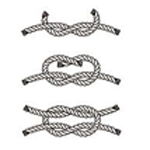
1. For those that want to tie up loose ends! The square/reef knot is a good choice for rope bondage as it applies less pressure to the skin. Used for trying two ropes together, or both ends of the same rope.
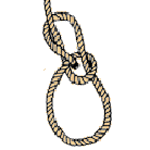
2. Tie a bow around your sub and turn them into your perfect gift! A bowline knot is perfect for binding the wrists and ankles. It won’t tighten, so you needn’t worry about circulatory problems.
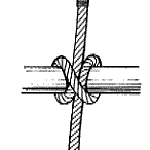
3. Want your rope work to go without a hitch? Well, this type of knot is perfect for use when tying to posts. However, it shouldn’t be used for suspension bondage or around the body.
Feeling slightly overwhelmed at the prospect of creating your own restraints, but eager to give it a go? Then have no fear; here are a few video tutorials to help you produce some simple yet extremely effective ties.
Meow! The bottom may hiss a bit, but there definitely won’t be any scratching when their hands are fastened in this restraint. Perfect for tying up or down, whether to your dungeon furniture or posts, the Cat’s Paw will keep the bottom secure for the duration of their punishment.
When it comes to the bottom’s release, our hands are tied. However, this is a great tie for beginners as it can easily be removed. Designed to stop those fingers from reaching for things that they shouldn’t, the wrists are tied together and the rope is then fastened behind the back to secure in place.
Cuff em’. A fantastic alternative to the typical ties used when preparing for a flogging. Other restraints tend to put a lot of pressure on the wrists, whereas the Rope Flogging Cuffs spread the weight evenly across the whole hand.
This is definitely one occasion where the wrapping is better than the unwrapping! The Ankle Wrap is perfect for any BDSM scene as it is designed to immobilise the bottom completely. It is sometimes used to keep the feet together in suspension bondage.
Slow down, eager beavers. Before you venture out on your exciting new kinky path, there’s a few things you need to know, namely about the types of rope that you’ll come across on your travels. There’s a few different types to play with out there, split into two categories: natural and synthetic. Let’s take a closer peek. Slow down, eager beavers. Before you venture out on your exciting new kinky path, there’s a few things you need to know, namely about the types of rope that you’ll come across on your travels. There’s a few different types to play with out there, split into two categories: natural and synthetic. Let’s take a closer peek.
Silk
Hemp
The most commonly used rope for Shibari, mostly because it has a more natural look, comes in plenty of colours and is more traditional, if you’re into that sort of thing. It also comes in a variety of diameters - so you can pick the right kind to suit your play. The downside? Washing can impact its durability, hemp sheds fibres, and it can sometimes cause allergic reactions - yikes. Just like your sub, you also need to ‘break in’ your hemp rope as it’s often quite stiff to begin with. It’s also a little on the expensive side.
Cotton
A great all-rounder. Cotton is strong but gentle on your skin, and has great elasticity. It’s also lightweight and won’t give anyone an allergic reaction or rope burns. On the other hand, it gets dirty quite easily, gets stretched out of shape, and can tie tight knots which are difficult to undo. Not one for beginners.
Jute
Another choice for the traditional kinksters out there, but jute is even more expensive. Washing or boiling can degrade the fibres, and it still needs time to be broken in. But on the upside, jute gets better and more flexible with each use, it can be dyed any colour, smells delightful, and is easy to untie. Certainly worth the money.
Linen/Flax
Let’s start with the cons first, because there’s only two - linen rope is pricey and it can be tricky to clean. But that’s it. It has a great tooth - which makes it easy to tie - good stretch, and is flexible and strong. It won’t cause allergic reactions and doesn’t need to be broken in, but it can leave marks so take extra care.
Bamboo
Manila, Sisal or Coir
Bottom of the list because, well, they’re our least favourite choices. Uncomfortable to use, unstable, and they definitely don’t have the strength for suspension. They’re also not easy to clean and don’t come with a great deal of choice diameter-wise. There are a few pros, of course; these are all cheaper options, leave good “rope marks” and have a harsh tooth.
Synthetic rope types
Polyester, nylon or paracord - Commonly known as nylon rope, these bad boys are smooth, soft, easy to find and easy to clean. They’re strong and won’t cause any allergies. Cons? Slippery, bad tooth, knots can become quite tight, and they can cause more prominent rope burns.
Synthetic hemp - Very similar to natural hemp, but it’s cheap and easy to clean. It also has a good tooth, its knots don’t get too compact, it doesn’t cause allergies and it’s strong enough to suspend. An all-round great synthetic option.
Multifilament polypropylene (MFP) - Sounds like a mouthful - which you may be enjoying later - but this rope type comes with plenty of benefits; it’s got low friction, good strength, and it’s soft and smooth, easy to get hold of and doesn’t cause allergies. On the other hand, it has poor tooth, leaves rope burns and isn’t suitable for suspension play.
When you do any kind of sexual experimentation - whether it’s rope, dildos or group play - safety always needs to come first. Don’t worry, you will soon. This is especially important with bondage rope play, as there is risk of asphyxiation and nerve compression. Fear not, however, follow these few dos and don’ts and you’ll be well on your way to tying yourself up in knots in all the right ways.
Do
- Plan out aftercare for your sub
- Discuss safewords and abide by them throughout
- Communicate with one another - now’s not the time to push limits
- Abide by the two finger rule - you should be able to fit two fingers comfortably between the rope and your sub’s skin
- Have sharp scissors within reach at all times to free your sub quickly
Don't
- Don’t tie knots too tightly to purposefully leave marks
- Don’t ignore safe words
- Never play with gags at the same time - you need to be able to hear your partner
- Never EVER leave a bound sub alone, even for a minute
- Never tie around the neck, underarms, and other joints like knees and elbows
- Don’t go straight for suspension - this requires a great deal of experience and practice
When it comes to any, and we mean any, kind of BDSM play, the importance of aftercare following your session cannot be underestimated. Aftercare simply refers to the time following your play session when you and your partner(s) take the time to tend to one another’s physical and emotional needs. Sessions that involve bondage rope tying or any kind of spanking, in particular, can really take a physical toll on a person. Aftercare functions as a way to get back to reality and ‘recalibrate’ yourself out of fantasy life.
Many subs can experience what is known as a ‘sub drop’ following the rush of endorphins, which can leave your sub feeling tired, dazed, physically weak and even dehydrated depending on the intensity of your playtime.
Aftercare looks different to each person, but here’s a few ways you can do it.
Physical Aftercare
- Removing all paraphernalia such as restraints, ropes or blindfolds
- Getting your sub something to eat and drink to boost blood sugar
- Wrapping them in a blanket or getting warm clothing
- Applying lotion or bruise cream to any areas that could have been impacted by spanking or rope tying
- Kissing and caressing these areas
- Slow, intimate massage
- Cuddling and hugging
- Take a bath or shower together
Emotional Aftercare
- Talking about your scene, both the good and bad parts
- Reassuring one another about their kink; reminding that you are normal and there is nothing ‘wrong’
- Providing a safe space for any raw emotions to come to the surface
- Being open to discussions in following days to ensure no negative feelings arise
A rope is for life, not just for a scene... Well it can be, if it’s shown the appropriate care. It is a good idea to clean ropes thoroughly prior to first use, and try to keep them off the ground during your play. This will avoid any unwelcome ‘friends’ taking up an invitation to join you.
For aftercare, wash ropes with warm water and soap. Alternatively, for a simpler clean you can pull your rope through a warm, damp cloth. In both of these cases, it is imperative to make sure that the rope is completely dry prior to storage.
For a thorough clean, hemp ropes can be washed on a gentle cycle in the washing machine or dishwasher. Nylon and cotton ropes can be bleached to keep them spic and span, however, this can weaken the fabric over time. Fabric softener can also be used to soften your ropes, however this can significantly reduce their life span too.
We know you like getting ‘dirty’, but there’s ‘dirty’, and then there’s dirty; so be sure to show your rope some respect.
Our Best Selling
Ropes
Less is more when it comes to purchasing the perfect beginner’s ring. For all of you newbies, we recommend;
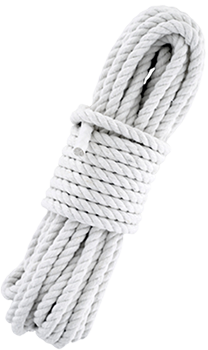
1. UberKinky Cotton Bondage Rope
"Love the feel of this super soft rope against my clit when I’m tied up. When tightened, it gives just the right amount of pressure to make me come!"
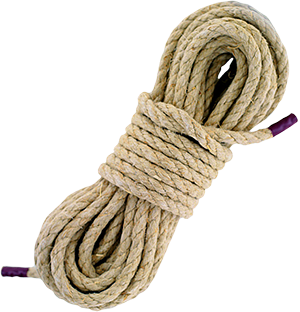
2. UberKinky Natural Hemp Bondage Rope
"This natural hemp rope from UberKinky smells just like straw and, despite its rough exterior, is still a real softie against the skin. Now we can play for even longer!"
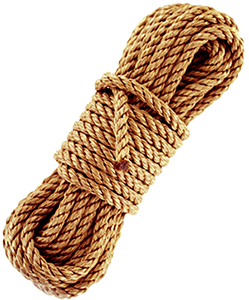
3. UberKinky Thempest Bondage Rope
"You can’t beat being tied up and tormented. This rope is incredibly strong and durable, but also feels silky soft against the skin. I absolutely adore making pretty patterns with it!"

